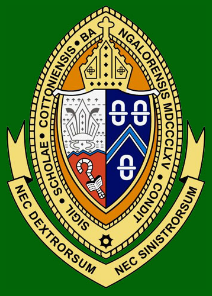Bishop Cotton Boys' School
| Bishop Cotton Boys' School | |
|---|---|

The School Arms
|
|
| Address | |
|
St. Mark's Road Bangalore, Karnataka India |
|
| Coordinates | 12°58′7.0″N 77°35′55.6″E / 12.968611°N 77.598778°ECoordinates: 12°58′7.0″N 77°35′55.6″E / 12.968611°N 77.598778°E |
| Information | |
| Type | Private school |
| Motto | "Nec Dextrorsum Nec Sinistrorsum" (Latin) (Neither to the Right Nor to the Left) |
| Established | 1865 |
| Founder | Rev. S. T. Pettigrew |
| Principal | John K. Zachariah |
| Enrollment | approx. 7,000 |
| Campus size | 14 acres (57,000 m2) |
| Houses | Pope, Pettigrew, Elphick, Pakenham Walsh, Thomas |
| Color(s) | Green and gold |
| Publication | The Cottonian, The Cotton Mill |
| Affiliation | Indian Certificate of Secondary Education Examination (ICSE) and the Indian School Certificate examination (ISC) |
| Former pupils | Old Cottonians |
| Website | http://cottonboys.com/ |
Bishop Cotton Boys' School is an all-boys school for boarders and day scholars in Bangalore, India, founded in memory of Bishop George Edward Lynch Cotton, Bishop of Calcutta.
The school is bordered by Residency Road, St Mark's Road, Lavelle Road and Vittal Mallya Road, and is spread over 14 acres (57,000 m2) of land in the heart of Bangalore.
School heads in the early days included George Uglow Pope, Herbert Pakenham-Walsh, S. T. Pettigrew, William Elphick, Iowerth Lowell Thomas and A. T. Balraj.
The sister school Bishop Cotton Girls High School is located across the street on St. Mark's Road and can be reached by a two-minute walk.
The school's past extends back to the British Raj and the Victorian era with its beginnings in a house on High Grounds over which now stands the great ITC Windsor Hotel . It was started in 1865 by Rev. S. T. Pettigrew, the then Chaplain of St. Mark's Cathedral who had a vision of starting a school for the education of children of European and Anglo-Indian families. In his own words, he wanted to "establish a day and boarding School for the Children of Christian residents in the station and its vicinity." The school was named in honour of George Cotton, Bishop of Calcutta, under whose stewardship a scheme of education was organized for the Anglican Churches in India. After India gained independence from the British in 1947, the school began to be, and is still governed by the Church of South India.
...
Wikipedia
